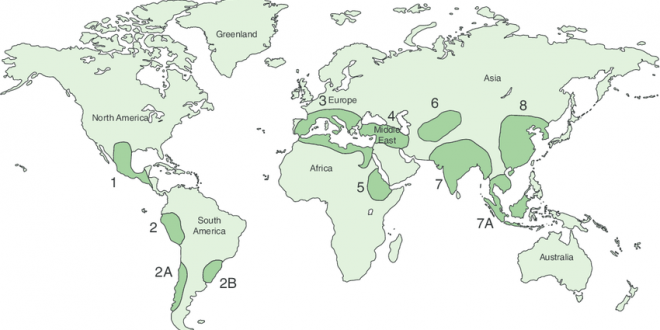Do you know what is Center of Origin?
The center of origin is a geographical area where the particular group of organisms (either domesticated or wild) first originated on earth.
This is the 3rd part of the topic: Concepts of center of origin of cultivated crops. If you have somehow missed the 1st & 2nd part here are the links to those articles-
- Concepts of center of origin of cultivated crops (Part 1)
- Concepts of center of origin of cultivated crops (Part 2)
Micro Centers
In some cases, small areas within the centers of diversity exhibit tremendous genetic diversity of some crop plants.
- These areas are referred to as micro centers.
- Micro centers are important sources for collecting valuable plant forms and also for the study of evolution of cultivated species.
- Main features:
- They represent small areas within the centers of diversity.
- Exhibit tremendous genetic diversity.
- The rate of natural evolution is faster than larger areas.
- They are important sites for the study of crop evolution.
Law of Homologous Series of Variation
- Vavilov also developed the concept of parallel series of variation or Law of homologous series of variation.
- This concept states that a particular variation observed in a crop species is also expected to be available in its other related species.
- For instance, if we get dwarf collections in one crop species the same may be found in another related species also.
Origin and Introduction of Plants
Human beings are heterotrophs. They derive their nutrition from plants and animals. But man has evolved from herbivorous ancestors. About two million years ago, the early Palaeolithic man started using weapons for hunting.
Later he began eating fruits and roots of wild plants. Much later, man started cultivating plants and raising animals and started a settled life.
The earliest settlements have been found to be located in the river valleys and plains of northern India. In these areas, the soil was fertile; plenty of water was available so, it was easy to cultivate crops. As a result of successful and plentiful agriculture production, people became self-sufficient and built great civilizations. Agriculture originated about 7000-13000 years ago, somewhere in the then well-watered highlands of the Indus, Euphrates and Nile and Tigris rivers. Some other prehistoric sites of ancient agricultural activity are Tehuacan valley in modern Mexico and banks of Yellow river in modern China.
South East Asia was ideal for agriculture beginning because of its diverse vegetation to support a stable human population. In these areas, planting of vegetative parts like rhizomes, tubers or bulbs which is simpler than ploughing of seeds formed the basis of agriculture.
But, it was seed-planting that led to more profound changes in the life of man. All early civilizations whose diets were known to us were based on seed reproducing plants such as wheat, maize or rice.
The agriculture originated independently in several parts of the world. The first conscious act of civilization was based on finding seeds and twigs struck into the ground. When a plant is raised consciously it is called cultivation. First, those plants were brought into cultivation that grow rapidly and produce crop within a season which include the present day cereals.
Cereals were originally weeds which grew in mountain areas of Asia, Europe and Africa (Old world) and North and South America (New world).
Domestication of Plants
The domestication of plants is the starting step in the direction of a full-fledged agricultural economy. A plant is termed as domestic when its natural characteristics are so much improved that it cannot grow and reproduce without human involvement.
Domestication is thought to be the result of the development of a symbiotic relationship between the plants and humans, called co-evolution, because plants and human behaviours evolve to suit one another.
Humans harvest a plant selectively based on specific characteristics like taste of the fruits, size of the flowers, colour of the flowers and fruits and so on. Humans use the seeds of these specific plants for further growth.
Basis of Plant Domestication
Majority of the plants were cultivated first during historical times and hence have very poor evidence. The paleontological data is usually entirely unavailable for cultivated plants and archaeological data is very poor and fragmented.
In the beginning of nineteenth century the origin of most of the cultivated species was not known. No species was common to the tropical regions of the two hemispheres before cultivation.
Strawberry, chestnut and mushrooms were common to northern regions of the world. A great number of species originated in Europe, India, West Asia, Brazil, and Colombia.
In short the original distribution of the cultivate species was very unequal. There was no proportion with the needs of the man and the number of plants cultivate.
Reference: Wikipedia
 Plantlet The Blogging Platform of Department of Botany, University of Dhaka
Plantlet The Blogging Platform of Department of Botany, University of Dhaka





